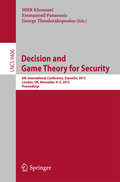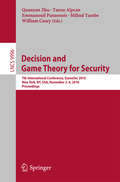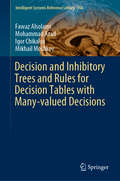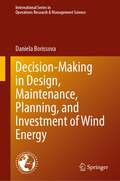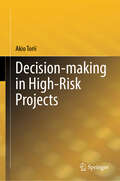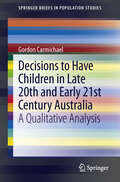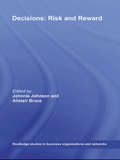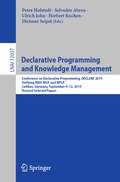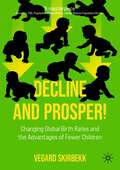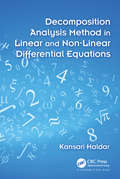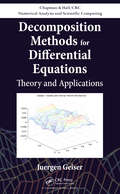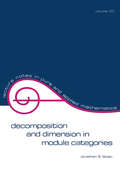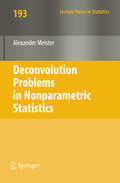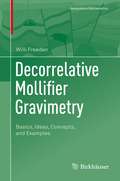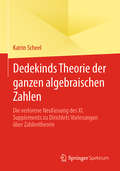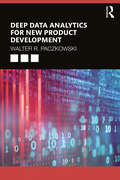- Table View
- List View
Decision Theory with a Human Face
by Richard BradleyWhen making decisions, people naturally face uncertainty about the potential consequences of their actions due in part to limits in their capacity to represent, evaluate or deliberate. Nonetheless, they aim to make the best decisions possible. In Decision Theory with a Human Face, Richard Bradley develops new theories of agency and rational decision-making, offering guidance on how 'real' agents who are aware of their bounds should represent the uncertainty they face, how they should revise their opinions as a result of experience and how they should make decisions when lacking full awareness of, or precise opinions on relevant contingencies. He engages with the strengths and flaws of Bayesian reasoning, and presents clear and comprehensive explorations of key issues in decision theory, from belief and desire to semantics and learning. His book draws on philosophy, economics, decision science and psychology, and will appeal to readers in all of these disciplines.
Decision and Game Theory for Security
by Mhr Khouzani Emmanouil Panaousis George TheodorakopoulosThis book constitutes the refereed proceedings of the 6th International Conference on Decision and Game Theory for Security, GameSec 2015, held in London, UK, in November 2015. The 16 revised full papers presented together with 5 short papers were carefully reviewed and selected from 37 submissions. Game and decision theory has emerged as a valuable systematic framework with powerful analytical tools in dealing with the intricacies involved in making sound and sensible security decisions. For instance, game theory provides methodical approaches to account for interdependencies of security decisions, the role of hidden and asymmetric information, the perception of risks and costs in human behaviour, the incentives/limitations of the attackers, and much more. Combined with our classical approach to computer and network security, and drawing from various fields such as economic, social and behavioural sciences, game and decision theory is playing a fundamental role in the development of the pillars of the "science of security".
Decision and Game Theory for Security
by Tansu Alpcan Emmanouil Panaousis Quanyan Zhu Milind Tambe William CaseyThis book constitutes the refereed proceedings of the 6th International Conference on Decision and Game Theory for Security, GameSec 2015, held in London, UK, in November 2015. The 16 revised full papers presented together with 5 short papers were carefully reviewed and selected from 37 submissions. Game and decision theory has emerged as a valuable systematic framework with powerful analytical tools in dealing with the intricacies involved in making sound and sensible security decisions. For instance, game theory provides methodical approaches to account for interdependencies of security decisions, the role of hidden and asymmetric information, the perception of risks and costs in human behaviour, the incentives/limitations of the attackers, and much more. Combined with our classical approach to computer and network security, and drawing from various fields such as economic, social and behavioural sciences, game and decision theory is playing a fundamental role in the development of the pillars of the "science of security".
Decision and Inhibitory Trees and Rules for Decision Tables with Many-valued Decisions (Intelligent Systems Reference Library #156)
by Igor Chikalov Mikhail Moshkov Fawaz Alsolami Mohammad AzadThe results presented here (including the assessment of a new tool – inhibitory trees) offer valuable tools for researchers in the areas of data mining, knowledge discovery, and machine learning, especially those whose work involves decision tables with many-valued decisions. The authors consider various examples of problems and corresponding decision tables with many-valued decisions, discuss the difference between decision and inhibitory trees and rules, and develop tools for their analysis and design. Applications include the study of totally optimal (optimal in relation to a number of criteria simultaneously) decision and inhibitory trees and rules; the comparison of greedy heuristics for tree and rule construction as single-criterion and bi-criteria optimization algorithms; and the development of a restricted multi-pruning approach used in classification and knowledge representation.
Decision-Making in Design, Maintenance, Planning, and Investment of Wind Energy (International Series in Operations Research & Management Science #355)
by Daniela BorissovaThis book demonstrates how decision-making models can be applied to solve specific real-life problems, with a particular emphasis on wind energy. In a step-by-step manner, it guides the reader through decision-making, the formulation of optimization models, and the methods for solving them. After providing an overview of various models for the design of wind farms, it presents an optimization model for deciding which economy (country) to invest in and models for selecting suppliers. A dedicated chapter focuses on different models for monitoring and predictive maintenance for wind turbines (farms) due to the construction of turbine blades and vibration. It shows how combinatorial optimization models can help to make optimal decisions for one-dimensional cutting stock of blanks, their processing, and determining the optimal composition for production. Moreover, it discusses how the energy consumption balance index formed by conventional and renewable sources can be determined and presents a means of identifying the relative share of wind energy consumption among the other renewable sources. Operations research professionals, students, and decision-makers alike will find this book to be a valuable resource for tackling real-world challenges and driving sustainable advances in wind energy solutions.
Decision-making in High-Risk Projects
by Akio ToriiThis book identifies and systematically confirms the various factors that allow dangerous nuclear power projects to proceed without adequate risk assessment, even as society recognizes the magnitude of risks associated with nuclear power generation. For the first time, it employs a communication game model to explore each factor individually. The novel feature of the book lies in its theoretical analysis of institutional factors, such as the possibility of regulatory capture by electric power companies, the likelihood of these companies concealing early warning signs, the societal demand for excessive safety leading to intolerance of even minor incidents, and the ambiguity of liability. These issues have been pointed out and discussed by many commentators, including the media, but they have never been rigorously verified through economic model analysis. Furthermore, the book discusses why trial and error, a common approach in technological development, is particularly challenging for nuclear power.
Decisions to Have Children in Late 20th and Early 21st Century Australia: A Qualitative Analysis
by Gordon CarmichaelThis book explores the process of decision-making around having children in a sample of 115 men, women and couples for whom family formation was a recent past, current or imminent future issue. The discussion is initially focused on the extent to which parenthood was contemplated in late adolescence and during the relationship formation/courtship process, and the process by which family sizes are determined. Decision-making associated with having first, second, third and fourth children is then examined in chapters entitled The First Child; The 'Obligatory' Second Child; The Discretionary Third Child and Fourth Children - Negative Reactions, Practical Issues. Decisions to Have Children in Late 20th and Early 21st Century Australia offers a detailed coverage of a topic with resonances and implications that apply to contemporary cultures all around the world.
Decisions: Risk and Reward (Routledge Studies In Business Organizations And Networks Ser.)
by Johnnie E.V. Johnson Alistair BruceIn recent years leading figures in a variety of fields - political, financial, medical, and organizational - have become acutely aware of the need to effectively incorporate aspects of risk into their decision-making. This book addresses a wide range of contemporary issues in decision research, such as how individuals deal with uncertainty and comp
Declarative Programming and Knowledge Management: Conference on Declarative Programming, DECLARE 2019, Unifying INAP, WLP, and WFLP, Cottbus, Germany, September 9–12, 2019, Revised Selected Papers (Lecture Notes in Computer Science #12057)
by Salvador Abreu Dietmar Seipel Petra Hofstedt Ulrich John Herbert KuchenThis book constitutes revised selected papers from the 22nd International Conference on Applications of Declarative Programming and Knowledge Management, INAP 2019, the 33rd Workshop on Logic Programming, WLP 2019, and the 27th Workshop on Functional and (Constraint) Logic Programming, WFLP 2019. The 15 full papers and 1 short paper presented in this volume were carefully reviewed and selected from 24 submissions. The contributions present current research activities in the areas of declarative languages and compilation techniques, in particular for constraint-based, logical and functional languages and their extensions, as well as discuss new approaches and key findings in constraint-solving, knowledge representation, and reasoning techniques.
Decline and Prosper!: Changing Global Birth Rates and the Advantages of Fewer Children
by Vegard SkirbekkGlobally, women are having half as many children as they had just fifty years ago. Why have birth rates fallen, and how will low fertility affect our shared future? In Decline and Prosper!, demographic expert Vegard Skirbekk offers readers an accessible, comprehensive and evidence-based overview of human reproduction. Readers learn about the evolution of childbearing across different populations and how fertility is related to (changes in) our reproductive capacity, contraception, education, religion, partnering, policies, economics, assisted reproduction, and catastrophes. Readers will explore the future of family size and its impact on human welfare, women’s empowerment and the environment. Skirbekk argues that low fertility is on the whole a good thing, while recognizing the challenges of population aging and “coincidental” childlessness. A balanced, integrative examination of one of the most important issues of our time, Decline and Prosper! drives home the fact that we must ultimately adapt to a world with fewer children. The book will be invaluable to anyone who is interested in the far-reaching effects of global fertility, including researchers and students of demography, social statistics, medical sociologists, family and childhood studies, human geographers, sociology of culture, social and public policy.
Decomposition Analysis Method in Linear and Nonlinear Differential Equations
by Kansari HaldarA Powerful Methodology for Solving All Types of Differential EquationsDecomposition Analysis Method in Linear and Non-Linear Differential Equations explains how the Adomian decomposition method can solve differential equations for the series solutions of fundamental problems in physics, astrophysics, chemistry, biology, medicine, and other scientif
Decomposition Methods for Differential Equations: Theory and Applications (Chapman & Hall/CRC Numerical Analysis and Scientific Computing Series)
by Juergen GeiserDecomposition Methods for Differential Equations: Theory and Applications describes the analysis of numerical methods for evolution equations based on temporal and spatial decomposition methods. It covers real-life problems, the underlying decomposition and discretization, the stability and consistency analysis of the decomposition methods, and num
Decomposition and Dimension in Module Categories (Lecture Notes In Pure And Applied Mathematics Ser. #33)
by Jonathan S. GolanThis book examines the notions of dimension and decomposition for module categories. It discusses some basic properties of quasidecomposition functions and the complete lattice of all quasidecomposition functions taking values in a fixed given lattice.
Deconvolution Problems in Nonparametric Statistics
by Alexander MeisterThis book gives an introduction to deconvolution problems in nonparametric statistics, e.g. density estimation based on contaminated data, errors-in-variables regression, and image reconstruction. Some real-life applications are discussed while we mainly focus on methodology (description of the estimation procedures) and theory (minimax convergence rates with rigorous proofs and adaptive smoothing parameter selection). In general, we have tried to present the proofs in such manner that only a low level of previous knowledge is needed. An appendix chapter on further results of Fourier analysis is also provided.
Decorrelative Mollifier Gravimetry: Basics, Ideas, Concepts, and Examples (Geosystems Mathematics)
by Willi FreedenThis monograph presents the geoscientific context arising in decorrelative gravitational exploration to determine the mass density distribution inside the Earth. First, an insight into the current state of research is given by reducing gravimetry to mathematically accessible, and thus calculable, decorrelated models. In this way, the various unresolved questions and problems of gravimetry are made available to a broad scientific audience and the exploration industry. New theoretical developments will be given, and innovative ways of modeling geologic layers and faults by mollifier regularization techniques are shown.This book is dedicated to surface as well as volume geology with potential data primarily of terrestrial origin. For deep geology, the geomathematical decorrelation methods are to be designed in such a way that depth information (e.g., in boreholes) may be canonically entered. Bridging several different geo-disciplines, this book leads in a cycle from the potential measurements made by geoengineers, to the cleansing of data by geophysicists and geoengineers, to the subsequent theory and model formation, computer-based implementation, and numerical calculation and simulations made by geomathematicians, to interpretation by geologists, and, if necessary, back. It therefore spans the spectrum from geoengineering, especially geodesy, via geophysics to geomathematics and geology, and back.Using the German Saarland area for methodological tests, important new fields of application are opened, particularly for regions with mining-related cavities or dense development in today's geo-exploration.
Dedekinds Theorie der ganzen algebraischen Zahlen: Die verlorene Neufassung des XI. Supplements zu Dirichlets Vorlesungen über Zahlentheorie
by Katrin ScheelDieses Buch stellt anhand des Nachlasses von Richard Dedekind eine Rekonstruktion des überarbeiteten XI. Supplements zur geplanten 5. Auflage von P. G. Lejeune Dirichlets Vorlesungen über Zahlentheorie mit einem Kommentar von Peter Ullrich zur Verfügung. Die von Dedekind herausgegebenen und erweiterten "Vorlesungen über Zahlentheorie" seines Lehrers Dirichlet und vor allem die umfangreichen angefügten Supplemente gelten als eines der Hauptwerke Dedekinds. Für die Geschichte der modernen Algebra ist das XI. Supplement "Über die Theorie der ganzen algebraischen Zahlen" von besonderem Interesse, da es die Begründung der Idealtheorie darstellt. Dedekind bereitete zu Beginn des 20. Jahrhunderts eine 5. Auflage der Vorlesungen von Dirichlet mit überarbeiteten Supplementen vor, die aber nicht mehr veröffentlicht wurde. Die Autorin dieses Bandes hat die Transkriptionsarbeiten und Editierung aus dem Dedekind Nachlass vorgenommen und ein einführendes Kapitel hinzugefügt.
Deductive Geometry (Dover Books on Mathematics)
by E. A. MaxwellThis concise review examines the geometry of the straight line, circle, plane, and sphere as well as their associated configurations, including the triangle and the cylinder. Aimed at university undergraduates, the treatment is also useful for advanced students at the secondary level.The straightforward approach begins with a recapitulation of previous work on the subject, proceeding to explorations of advanced plane geometry, solid geometry with some reference to the geometry of the sphere, and a chapter on the nature of space, including considerations of such properties as congruence, similarity, and symmetry. The text concludes with a brief account of the elementary transformations of projection and inversion. Numerous examples appear throughout the book.
Deep Data Analytics for New Product Development
by Walter R. PaczkowskiThis book presents and develops the deep data analytics for providing the information needed for successful new product development. Deep Data Analytics for New Product Development has a simple theme: information about what customers need and want must be extracted from data to effectively guide new product decisions regarding concept development, design, pricing, and marketing. The benefits of reading this book are twofold. The first is an understanding of the stages of a new product development process from ideation through launching and tracking, each supported by information about customers. The second benefit is an understanding of the deep data analytics for extracting that information from data. These analytics, drawn from the statistics, econometrics, market research, and machine learning spaces, are developed in detail and illustrated at each stage of the process with simulated data. The stages of new product development and the supporting deep data analytics at each stage are not presented in isolation of each other, but are presented as a synergistic whole. This book is recommended reading for analysts involved in new product development. Readers with an analytical bent or who want to develop analytical expertise would also greatly benefit from reading this book, as well as students in business programs.
Deep Down Things: The Breathtaking Beauty of Particle Physics
by Bruce A. SchummA useful scientific theory, claimed Einstein, must be explicable to any intelligent person. In Deep Down Things, experimental particle physicist Bruce Schumm has taken this dictum to heart, providing in clear, straightforward prose an elucidation of the Standard Model of particle physics—a theory that stands as one of the crowning achievements of twentieth-century science. In this one-of-a-kind book, the work of many of the past century's most notable physicists, including Einstein, Schrodinger, Heisenberg, Dirac, Feynman, Gell-Mann, and Weinberg, is knit together in a thorough and accessible exposition of the revolutionary notions that underlie our current view of the fundamental nature of the physical world. Schumm, who has spent much of his life emmersed in the subatomic world, goes far beyond a mere presentation of the "building blocks" of matter, bringing to life the remarkable connection between the ivory tower world of the abstract mathematician and the day-to-day, life-enabling properties of the natural world. Schumm leaves us with an insight into the profound open questions of particle physics, setting the stage for understanding the progress the field is poised to make over the next decade or two.Introducing readers to the world of particle physics, Deep Down Things opens new realms within which are many clues to unraveling the mysteries of the universe.
Deep Generative Modeling
by Jakub M. TomczakThis textbook tackles the problem of formulating AI systems by combining probabilistic modeling and deep learning. Moreover, it goes beyond typical predictive modeling and brings together supervised learning and unsupervised learning. The resulting paradigm, called deep generative modeling, utilizes the generative perspective on perceiving the surrounding world. It assumes that each phenomenon is driven by an underlying generative process that defines a joint distribution over random variables and their stochastic interactions, i.e., how events occur and in what order. The adjective "deep" comes from the fact that the distribution is parameterized using deep neural networks. There are two distinct traits of deep generative modeling. First, the application of deep neural networks allows rich and flexible parameterization of distributions. Second, the principled manner of modeling stochastic dependencies using probability theory ensures rigorous formulation and prevents potential flaws in reasoning. Moreover, probability theory provides a unified framework where the likelihood function plays a crucial role in quantifying uncertainty and defining objective functions. Deep Generative Modeling is designed to appeal to curious students, engineers, and researchers with a modest mathematical background in undergraduate calculus, linear algebra, probability theory, and the basics in machine learning, deep learning, and programming in Python and PyTorch (or other deep learning libraries). It will appeal to students and researchers from a variety of backgrounds, including computer science, engineering, data science, physics, and bioinformatics, who wish to become familiar with deep generative modeling. To engage the reader, the book introduces fundamental concepts with specific examples and code snippets. The full code accompanying the book is available on github. The ultimate aim of the book is to outline the most important techniques in deep generative modeling and, eventually, enable readers to formulate new models and implement them.
Deep Generative Modeling
by Jakub M. TomczakThis first comprehensive book on models behind Generative AI has been thoroughly revised to cover all major classes of deep generative models: mixture models, Probabilistic Circuits, Autoregressive Models, Flow-based Models, Latent Variable Models, GANs, Hybrid Models, Score-based Generative Models, Energy-based Models, and Large Language Models. In addition, Generative AI Systems are discussed, demonstrating how deep generative models can be used for neural compression, among others. Deep Generative Modeling is designed to appeal to curious students, engineers, and researchers with a modest mathematical background in undergraduate calculus, linear algebra, probability theory, and the basics of machine learning, deep learning, and programming in Python and PyTorch (or other deep learning libraries). It should find interest among students and researchers from a variety of backgrounds, including computer science, engineering, data science, physics, and bioinformatics who wish to get familiar with deep generative modeling. In order to engage with a reader, the book introduces fundamental concepts with specific examples and code snippets. The full code accompanying the book is available on the author's GitHub site: github.com/jmtomczak/intro_dgm The ultimate aim of the book is to outline the most important techniques in deep generative modeling and, eventually, enable readers to formulate new models and implement them.
Deep Generative Models: 4th MICCAI Workshop, DGM4MICCAI 2024, Held in Conjunction with MICCAI 2024, Marrakesh, Morocco, October 10, 2024, Proceedings (Lecture Notes in Computer Science #15224)
by Anirban Mukhopadhyay Sandy Engelhardt Ilkay Oksuz Yixuan Yuan Dorit MehrofThis book constitutes the proceedings of the 4th workshop on Deep Generative Models for Medical Image Computing and Computer Assisted Intervention, DGM4MICCAI 2024, held in conjunction with the 27th International conference on Medical Image Computing and Computer Assisted Intervention, MICCAI 2024, in Marrakesh, Morocco in October 2024. The 21 papers presented here were carefully reviewed and selected from 40 submissions. These papers deal with a broad range of topics, ranging from methodology (such as Causal inference, Latent interpretation, Generative factor analysis) to Applications (such as Mammography, Vessel imaging, Surgical videos and more).
Deep Generative Models: 5th MICCAI Workshop, DGM4MICCAI 2025, Held in Conjunction with MICCAI 2025, Daejeon, South Korea, September 23, 2025, Proceedings (Lecture Notes in Computer Science #16128)
by Anirban Mukhopadhyay Sandy Engelhardt Ilkay Oksuz Yixuan Yuan Dorit MehrofThis book constitutes the proceedings of the 5th Workshop on Deep Generative Models for Medical Image Computing and Computer Assisted Intervention, DGM4MICCAI 2025, held in conjunction with the 28th International Conference on Medical Image Computing and Computer Assisted Intervention, MICCAI 2025, in Daejeon, South Korea, during September 2025.The 33 papers presented in this book were carefully reviewed and selected from 50 submissions. These papers deal with recent algorithmic developments, new results, and promising future directions in Deep Generative Models.
Deep Homology?
by Held Lewis I. Jr.Humans and flies look nothing alike, yet their genetic circuits are remarkably similar. Here, Lewis I. Held, Jr compares the genetics and development of the two to review the evidence for deep homology, the biggest discovery from the emerging field of evolutionary developmental biology. Remnants of the operating system of our hypothetical common ancestor 600 million years ago are compared in chapters arranged by region of the body, from the nervous system, limbs and heart, to vision, hearing and smell. Concept maps provide a clear understanding of the complex subjects addressed, while encyclopaedic tables offer comprehensive inventories of genetic information. Written in an engaging style with a reference section listing thousands of relevant publications, this is a vital resource for scientific researchers, and graduate and undergraduate students.
Deep Learning Applications for Cyber Security (Advanced Sciences and Technologies for Security Applications)
by Mamoun Alazab MingJian TangCybercrime remains a growing challenge in terms of security and privacy practices. Working together, deep learning and cyber security experts have recently made significant advances in the fields of intrusion detection, malicious code analysis and forensic identification. This book addresses questions of how deep learning methods can be used to advance cyber security objectives, including detection, modeling, monitoring and analysis of as well as defense against various threats to sensitive data and security systems. Filling an important gap between deep learning and cyber security communities, it discusses topics covering a wide range of modern and practical deep learning techniques, frameworks and development tools to enable readers to engage with the cutting-edge research across various aspects of cyber security. The book focuses on mature and proven techniques, and provides ample examples to help readers grasp the key points.

